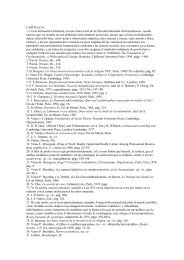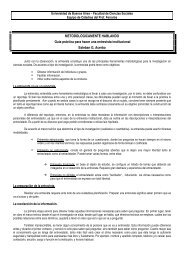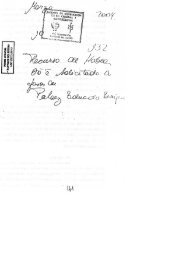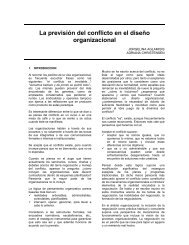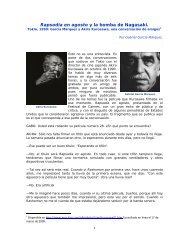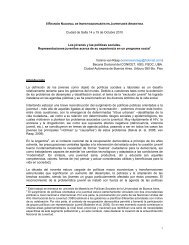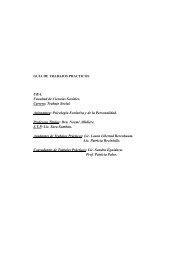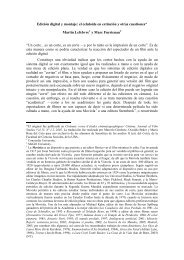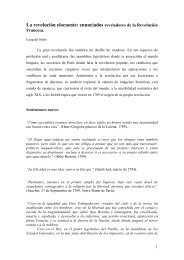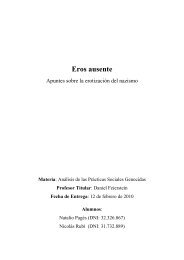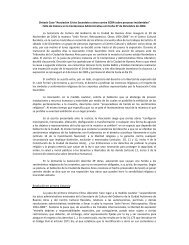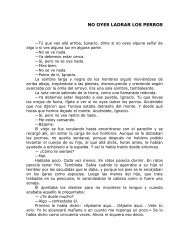Charisma Reconsidered
Charisma Reconsidered
Charisma Reconsidered
You also want an ePaper? Increase the reach of your titles
YUMPU automatically turns print PDFs into web optimized ePapers that Google loves.
seen to be a ‘rational’ one, but a rational one in a special sense. One might<br />
compare it in some respects to Buchanan’s (2001) notion of ‘constitutional<br />
choice’, the choice to live under a particular kind of constitutional order. Like<br />
these choices, the choice to follow a charismatic leader is a drastic, all-or-nothing<br />
choice in which many elements of the alternatives are bound up with one another.<br />
But ‘charismatic choice’ is a life-style and belief-system choice in which beliefs<br />
about risk, about what is dangerous, are changed.<br />
To put this in more general terms, there are actions that ‘prove’ that one’s<br />
assessments of risk need revision. The choice to submit to a leader is a subcategory<br />
of this larger category: the path represented by the leader corresponds to<br />
a new line in a decision matrix, in terms of which submission is a rational means to<br />
an end with a new risk term. The same kind of inner transformation, a transformation<br />
in beliefs about what is possible (meaning what can be done without<br />
incurring overwhelming danger), is made, but in the case of choice of a leader, the<br />
belief is that what is possible is possible only though submission to the leader. Not<br />
surprisingly, there are situations in which this kind of choice becomes more<br />
rational, in the sense of relatively less risky. Times of trouble or hopelessness are<br />
times in which taking chances becomes a rational strategy because there is less to<br />
lose.<br />
Risk is a part of rational calculation, but it is a curiously irrational part.<br />
Writers like Mary Douglas (1992) argue that risk should be understood as a<br />
cultural concept, because risk perceptions vary culturally. But one need not invoke<br />
some sort of notion of culture as a system of shared beliefs to see that risk is<br />
necessarily ‘social’. Most risks cannot be learned about by trial and error, simply<br />
because the trial itself is dangerous. One cannot tell a child: ‘Play in the street, and<br />
learn for yourself that a car will run you over.’ Thus much of our understanding of<br />
risk necessarily comes from others, and, similarly, even those who tell us about<br />
risks typically have not tested the risk themselves.<br />
These simple considerations point to a solution to another problem, the<br />
relationships between risk and magic, magic and taboo, and charisma and magic.<br />
Weber discussed these topics in Economy and Society (1978 [1922] ) in a section<br />
on magic and religion, in which he applies these ideas to the Polynesian case, an<br />
application that is made more interesting by the fact that it has close parallels to<br />
the highly influential discussion of taboo by Steiner, which influenced Mary<br />
Douglas’s account of purity and danger (Douglas, 1999: 11). Weber comments<br />
that the idea of obedience to religious law is preceded by a form of religious ethics<br />
that is magical, and in which violation of norms is a religious abomination. Thus<br />
where there exists a belief in spirits, the idea develops that spirits enter into a<br />
person, that one must not irritate the spirit, and that persons who are inhabited by<br />
a spirit must be isolated out of fear of contamination. Out of this reasoning,<br />
Weber suggests, arose the notion of taboo, of objects or persons endowed with<br />
the quality of taboo, which in turn could be transmitted by magical means by<br />
persons possessing, as he calls it, magical charisma. The rationalization of taboos<br />
TURNER CHARISMA RECONSIDERED 17



